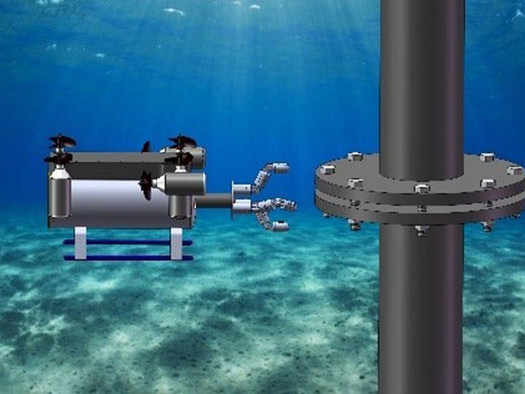January 2024, Vol. 251, No. 1
Tech Notes
Cost-Effective Robot for Subsea Inspection Under Development
Special to P&GJ
University of Houston researchers are developing an autonomous robot to identify potential pipeline leaks and structural failures during subsea inspections. The transformative technology will make the inspection process far safer and more cost effective, while also protecting subsea environments from disaster.
While most spills in U.S. waters are small, spilled crude oil can still cause damage to sensitive areas such as beaches, mangroves and wetlands. When larger spills happen, pipelines are often the culprit.
The SmartTouch technology now in development at UH consists of Remote Operated Vehicles (ROVs) equipped with multiple stress wave-based smart touch sensors, video cameras and scanning sonars that can swim along a subsea pipeline to inspect flange bolts – bolted connections have accelerated the rate of pipeline accidents that result in leakage, according to the Bureau of Safety and Environmental Enforcement (BSEE).
The BSEE is funding the project with a $960,493 grant to UH researchers, who are working in collaboration with Oceaneering International and Chevron.
“By automating the inspection process with this state-of-the art robotic technology, we can dramatically reduce the cost and risk of these important subsea inspections which will lead to safer operations of offshore oil and gas pipelines as less intervention from human divers will be needed,” said Chen.
A prototype of the ROV has been tested in his lab and in Galveston Bay. The experiments demonstrated the feasibility of the proposed approach for inspecting the looseness of subsea bolted connections. Preliminary studies were funded by UH’s Subsea Systems Institute.
Oil and gas pipelines fail for a variety of reasons, including equipment malfunctions, corrosion, weather and other natural causes, or vessel-related accidents which account for most large leaks.
“Corrosion is responsible for most small leaks, but the impacts can still be devastating to the environment. Therefore, our technology will be highly accurate in monitoring corrosion and will also help mitigate the chances of pipeline failure from other factors,” said co-principal investigator Gangbing Song, who has conducted significant research in piezoelectric-based structural health monitoring.
His prior research efforts include numerous damage detection applications, such as crack detection, hydration monitoring, debonding and other structural anomalies.
The UH researchers are collaborating with Oceaneering International, an industrial leader in ROV development, non-destructive testing and inspections, engineering and project management, and surveying and mapping services. Additionally, Chevron, a major oil and gas operator, will evaluate the technology’s future commercialization.






Comments